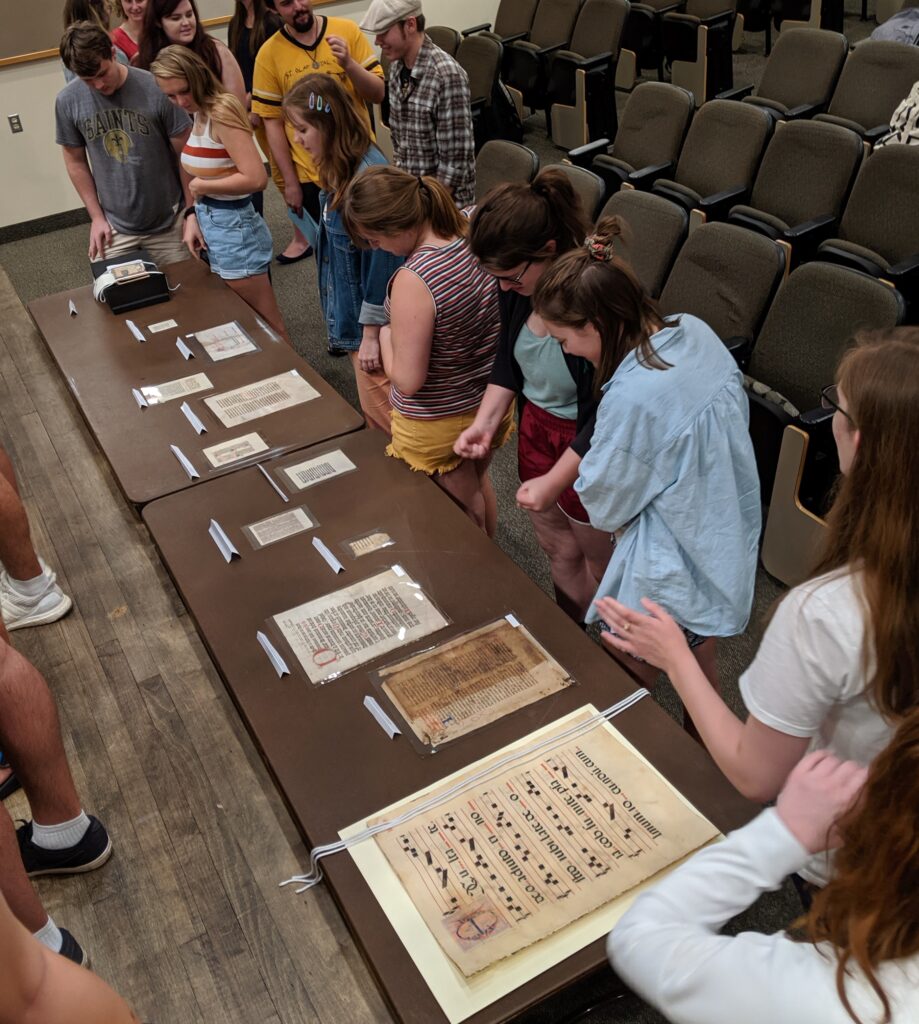This summer, thanks to YouTube, I had the chance to watch Eric Ensley, Curator of Books and Maps at the University of Iowa Special Collections and Archives, summer seminar on “The Biblioclasts: Is it ever ethical to break a book?”. His question is one I think many of us are grappling with as we look at the collections of leaves at our institution. Prior to joining as a partner on this project, I knew next to nothing about Otto Ege, the infamous bookbreaker whose portfolios are present in so many of our institutions. And I was completely ignorant of the second biblioclast Ensley discusses, David Magee from Grabhorn Press. A quick catalog search showed that we have one of the Grabhorn Press leaf books in our collection. In watching Ensley’s talk, I learned more about Ege’s rationale for book breaking: for institutions to teach with materials they need to have the materials on hand. A leaf collection provides an opportunity to have access to medieval manuscript materials. While Ege’s original intent may have been to support teaching, Ensley’s final answer to his question has spurred me to think more about how I teach with our medieval manuscript leaves. Ensley says: “Is it ever ethical to break a book? Perhaps. But, as Ege enriching our teaching through the bitter calculus of his portfolios shows, there’s a danger that, in breaking books, one loses a context that may make us societally poorer, as it augments our pedagogical capabilities.” It is Ensley’s point on the loss of context that has inspired me to reflect on my teaching practice and also increased my excitement for the Peripheral Manuscripts project.
I do not believe in the continued practice of book breaking. Nor do I need to run any numbers to know that our collection of medieval leaves and our book of hours are the items most used in my classes. I share them with English students, Art History and History students and have even held a “paleography party” for faculty to come and examine our leaves for a few hours. Each spring, almost 100 students in our Great Conversation program are introduced to our medieval manuscripts during what has become my annual plenary. Having the leaves helped me establish connections with faculty and students when I started at St. Olaf three years ago. They have helped me convince faculty that a field trip to a large institution isn’t necessary when students can come visit and research medieval manuscripts in their home library. I think the leaf collections we have are being used as Otto Ege hoped—they have augmented my teaching.

They have also inspired me to think creatively about how I teach with these objects, and I hope I provide the missing context that each leaf loses when separated from the original codex. In addition to showing students our book of hours and manuscript leaves, I have built a teaching collection of related objects. With each class I bring out my “touch and feel” collection which includes: a full goat skin, scraps of various parchment, bookbinding models that range from a wax tablet to a 15th-century limp vellum binding, and more recently quills and black walnut ink. By interacting with these objects, learning the process for making manuscripts, and studying our various leaves, my intention is to fill in some of the missing context.

The prospect of comparing our collections with others included in the Peripheral Manuscripts digital collection is an exciting one. I’m looking forward to introducing students to our local collection and then directing them to the digital repository to begin filling in some of the context that is lost when looking at individual leaves. Soon students will be able to compare leaves digitally and perhaps observe how the format of a type of religious text changes over time or note the stylistic differences between scribes in France versus Italy. There could also be the opportunity to see leaves from the same book spread across institutions. I think the Peripheral Manuscripts project will yield many ways for us to contextualize and increase our understanding of our leaf collections.
By Jillian Sparks, Librarian for Special Collections and Archives Instruction, St. Olaf College